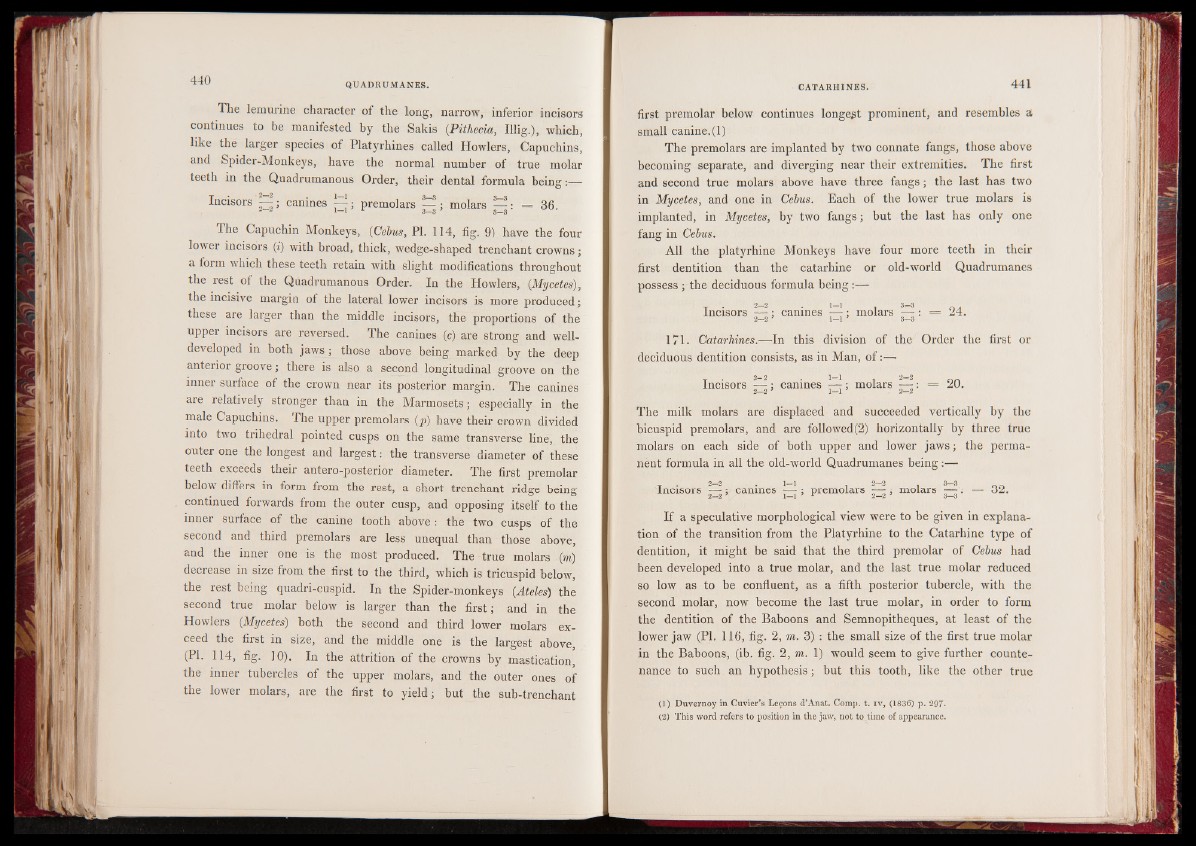
The lemurine character of the long, narrow, inferior incisors
continues to be manifested by the Sakis (Pithecia, Illig.), which,
like the larger species of Platyrhines called Howlers, Capuchins,
and Spider-Monkeys, have the normal number of true molar
teeth in the Quadrumanous Order, their dental formula being:—
Incisors — ; canines ~ ; premolars — ; molars ^ : = 36.
The Capuchin Monkeys, (Cebus, PI. 114, fig. 9) have the four
lower incisors (i) with broad, thick, wedge-shaped trenchant crowns;
a form which these teeth retain with slight modifications throughout
the rest of the Quadrumanous Order. In the Howlers, (.Mycetes),
the incisive margin of the lateral lower incisors is more produced;
these are larger than the middle incisors, the proportions of the
upper incisors are reversed. The canines (c) are strong and well-
developed in both jaws; those above being marked by the deep
anterior groove; there is also a second longitudinal groove on the
inner surface of the crown near its posterior margin. The canines
are relatively stronger than in the Marmosets; especially in the
male Capuchins. The upper premolars (p) have their crown divided
into two trihedral pointed cusps on the same transverse line, the
outer one the longest and largest: the transverse diameter of these
teeth exceeds their antero-posterior diameter. The first premolar
below differs in form from the rest, a short trenchant ridge being
continued forwards from the outer cusp, and opposing itself to the
inner surface of the canine tooth above : the two cusps of the
second and third premolars are less unequal than those above,
and the inner one is the most produced. The true molars (m)
decrease in size from the first to the third, which is tricuspid below,
the rest being quadri-cuspid. In the Spider-monkeys (Ateles) the
second true molar below is larger than the first; and in the
Howlers {Mycetes) both the second and third lower molars exceed
the first in size, and the middle one is the largest above,
(PI. 114, fig. 10). In the attrition of the crowns by mastication,
the inner tubercles of the upper molars, and the outer ones of
the lower molars, are the first to yield; but the sub-trenchant
first premolar below continues longest prominent, and resembles a
small canine. (1)
The premolars are implanted by two connate fangs, those above
becoming separate, and diverging near their extremities. The first
and second true molars above have three fangs; the last has two
in Mycetes, and one in Cebus. Each of the lower true molars is
implanted, in Mycetes, by two fangs; but the last has only one
fang in Cebus.
All the platyrhine Monkeys have four more teeth in their
first dentition than the catarhine or old-world Quadrumanes
possess ; the deciduous formula being :—
t Inci• sors 2——2 ; can• ines 1——1 ; molia rs 3«- 8js = 2c4 a. 2—2 ’ 1—1 ’ 3—3
171. Catarhines.—In this division of the Order the first or
deciduous dentition consists, as in Man, of:—
Incisors — : canines —I ; molars : — 20. 2—2 1—1 - 2—2
The milk molars are displaced and succeeded vertically by the
bicuspid premolars, and are followed (2) horizontally by three true
molars on each side of both upper and lower jaws; the permanent
formula in all the old-world Quadrumanes being:—
Incisors caninessfcl;: premolars molars — : =» 32.
If a speculative morphological view were to be given in explanation
of the transition from the Platyrhine to the Catarhine type of
dentition, it might be said that the third premolar of Cebus had
been developed into a true molar, and the last true molar reduced
so low as to be confluent, as a fifth posterior tubercle, with the
second molar, now become the last true molar, in order to form
the dentition of the Baboons and Semnopitheques, at least of the
lower jaw (PI. 116, fig. 2, m. 3) : the small size of the first true molar
in the Baboons, (ib. fig. 2, m. 1) would seem to give further countenance
to such an hypothesis; but this tooth, like the other true
(1) Duvernoy in Cuvier’s Leçons d’Anat. Comp. t. iv, (1836) p. 297-
(2) This word refers to position in the jaw, not to time of appearance.